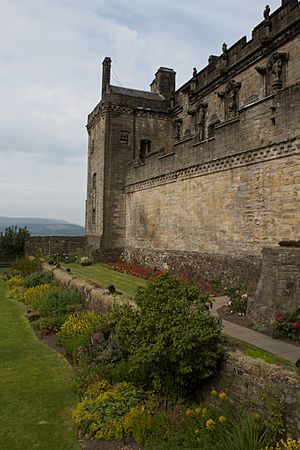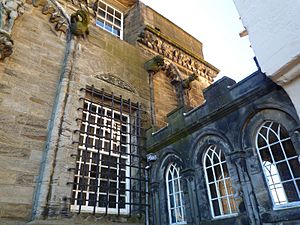Baptism of James VI facts for kids
The baptism of James VI was a huge party held at Stirling Castle in December 1566. It was a big celebration for the birth of Prince James, the son of Mary, Queen of Scots. The event included a special play (called a masque), amazing fireworks, and even a pretend attack on a fake castle! Two clever people, George Buchanan and Bastian Pagez, helped plan all the fun.
Contents
Meet Prince James

Prince James was born on July 19, 1566, at Edinburgh Castle. His parents were Mary, Queen of Scots, and Henry Stuart, Lord Darnley. Soon after he was born, he was taken to Stirling Castle. A special nursery was set up just for him there.
His cradle was made by the queen's special furniture maker, Nicholas Guillebault. It had a fancy blue canopy. Five important people, including the queen's niece, Christine Stewart, took turns rocking him. The prince also had a household of helpers at Stirling, including Lady Reres.
Fancy Clothes and Colours
For the baptism, many people wore new, fancy clothes. Lady Reres and the prince's nurse, Helen Littil, wore black velvet gowns. It was said that Queen Mary paid for many of these clothes herself. She wanted everyone to look their best for the big event.
Mary even gave clothes to some people that were fancier than what they usually wore. This was to show how important the day was. An English official, John Forster, heard that Mary ordered clothes in specific colours for some important lords. For example, the Earl of Bothwell got blue, the Earl of Argyll got red, and the Earl of Moray got green. She also asked her lords to bring their own helpers dressed in bright colours. Everyone was busy getting ready at Stirling!
Getting Ready for the Big Party
Queen Mary sent out invitations for the baptism in August 1566. The Privy Council, a group of royal advisors, decided to raise money for the party. They collected £12,000 Scots to entertain the important guests from other countries. This money came from different parts of Scotland.
Most of the party's costs were paid from this special tax. There are records of making fireworks and costumes for soldiers. The Great Hall, where the main party would be, was also decorated. Mary's servant, Servais de Condé, helped with this. Prince James's bed for the baptism even had a cover made of silver cloth! Old velvet and damask beds were fixed up. Nicolas Guillebault, the furniture maker, covered chairs and stools with velvet and Morocco leather.
The events at the baptism were similar to a big festival held in France in 1565. At that party, a fake castle was attacked to show the triumph of Christianity. At Stirling, actors dressed as "devils" and "Moors" (African people) attacked a pretend castle.
George Buchanan, a poet who would later teach the young king, wrote some of the entertainment. Bastian Pagez, a French helper, designed the costumes and planned the dances. He was given special fabric for "preparatives," which might have been costumes for the satyrs (mythical creatures) in the show.
Fireworks and a Mock Castle
Soldiers and gunners from Edinburgh and Stirling castles made the fireworks. Michael Gardiner and John Chisholm were in charge. John Chisholm had to ask the Queen for extra money because the preparations were so expensive! He used things like colophony (a type of resin), orpiment (a yellow mineral), and quicksilver to make the fireworks.
The fireworks were made secretly in a town called Leith. They were brought to Stirling Castle at night so no one would know about them. John Chisholm also helped make costumes for the soldiers who acted in the mock castle attack. Some blue fabric was dyed black for these costumes. Four soldiers wore costumes and wigs made of lamb's fleece to look like "Moors" (African people). A carpenter named James Reid built the fake fort near the churchyard.
The French ambassador, Jean, Count de Brienne, arrived in Edinburgh in November 1566. He visited Queen Mary, who had been ill. The baptism was planned for December 10 but was delayed by a week. Brienne went to Stirling on December 12.
The Baptism Ceremony
The actual baptism ceremony happened at Stirling on December 17. Prince James was given many important names and titles, including "Charles James, James Charles, Prince and Steward of Scotland."
After the ceremony, there was a big banquet with torches. People danced and played. The day ended with a special play where men on pretend horses sang in Italian.
Darnley and Bothwell
Prince James's father, Lord Darnley, was not getting along well with Queen Mary. He stayed privately in the castle and did not attend the celebrations. A French diplomat, Philibert du Croc, was told not to speak to Darnley by the King of France.
It was said that Mary had a special passage built between her room and the Great Hall where another lord, Bothwell, stayed. This building work was not finished.
Fireworks and a Pretend Battle
On December 19, there was another fireworks display. This time, it was part of a show where "wildmen" attacked a pretend castle. Twenty-eight Highland wildmen, dressed in goatskins and carrying fireworks, fought against fifteen soldiers. These soldiers were dressed as different types of warriors, including "Moors" and devils. They even had two small cannons!
Dancers with Tails at the Feast
On December 19, 1566, there was a grand feast and entertainment in the Great Hall of the castle. Food was brought from the kitchens in a procession with musicians.
James Melville of Halhill, who was there, wrote about a show that offended the English guests. Queen Mary and thirty guests sat at a round table, like the famous King Arthur's. The food was brought in on a moving table. Twelve men dressed as satyrs (mythical creatures with tails) pulled the table. They carried torches and whips to clear the way.
When the table reached the stage, the satyrs passed their torches to others. Then, six servers dressed as nymphs (nature spirits) passed the food to the satyrs, who brought the dishes to the Queen's table.
While this was happening, people dressed as nymphs and satyrs sang Latin songs. These songs were written by George Buchanan and praised the food and the hosts. The songs were sung by different characters, including satyrs, nereids (sea nymphs), fauns (forest spirits), and naiads (water nymphs). Characters representing the Orkney Islands finished the song. Some of the nereids were said to have traveled from the "New World" (the Americas), representing Native Americans.
When the satyrs wagged their tails, some English guests thought it was a joke about an old story that Englishmen had tails. This old story came from the Middle Ages. It was a legend that a saint had cursed some people in England to have tails. From this old tale, it became a common saying in Europe that all Englishmen had secret tails.
Melville thought the English guests should have just ignored the joke. Some of them, like Christopher Hatton, even turned their backs to the show. Queen Mary and the English ambassador, the Earl of Bedford, had to calm things down. Hatton even said he would have hurt Bastian Pagez for the joke!
The moving table was brought into the hall four times for four different courses of food. Each time, its decorations changed. During the fourth course, a child actor came down from the roof in a globe. The stage machine broke during the fifth course.
Important Guests and Gifts
Francis Russell, 2nd Earl of Bedford, represented Queen Elizabeth I of England at the baptism. He was the main guest of honour. Queen Elizabeth gave him a gold chain with pearls, diamonds, and rubies. Bedford refused to go into the chapel for the baptism itself. Instead, Jean Stewart, Countess of Argyll, went in his place. Bedford gave her a ruby ring from Queen Elizabeth. He also brought a beautiful gold font (a basin for baptism) as a gift from Queen Elizabeth.
According to James Melville, Queen Mary gave Christopher Hatton a pearl chain and a diamond ring. She gave George Carey a ring and a chain with her miniature picture. She also gave gold chains to other English gentlemen. The French ambassador gave Mary a necklace of pearls and rubies. Later, in January 1567, an ambassador from the Duke of Savoy gave Mary a fan with jeweled feathers.
After the baptism, James Stewart, 1st Earl of Moray, took the Earl of Bedford on a tour of Fife. They visited St Andrews. Queen Mary went to Drummond Castle and Tullibardine Castle for New Year's. Lord Darnley, her husband, went to Glasgow instead.
Some tapestries and a Turkish carpet were lost from Stirling Castle during the time of the baptism.
More Parties at the Royal Court
Years later, in January 1581, there was another big wedding celebration. James Stewart married Elizabeth Stewart. The wedding included a tournament where people rode horses and tried to catch rings with their lances. King James VI himself took part! Two days later, there was a water show in Leith. It ended with a pretend attack on a fake castle built on boats.
Prince Henry, the eldest son of James VI and Anne of Denmark, was also baptized at Stirling in 1594. Those celebrations included another tournament. Desserts and fruits were served by six ladies from a moving stage pulled by a "Moor" (an African person). There was also a model ship made of sugar, filled with sugar fish!
|



